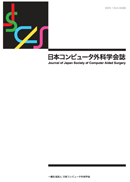
- 4 号 p. 179-
- 3 号 p. 121-
- 2 号 p. 61-
- 1 号 p. 3-
- |<
- <
- 1
- >
- >|
-
佐藤 嘉伸2017 年 19 巻 1 号 p. 3
発行日: 2017年
公開日: 2017/03/09
ジャーナル フリーPDF形式でダウンロード (509K)
-
山田 篤史, 仲 成幸, 森川 茂廣, 谷 徹2017 年 19 巻 1 号 p. 5-16
発行日: 2017年
公開日: 2017/03/09
ジャーナル フリーTo steer a needle around delicate or bony structures during needle insertion for targeting tumor in minimally invasive surgery, we proposed a novel continuum mechanism named “Active Sheath” and applied the mechanism to develop a novel steerable needle. The kinematics of the proposed mechanism was presented based on the deformed shapes simulated numerically using finite element methods to predict the steered shape of Active Sheath promptly. The developed steerable needle with 3 mm outer diameter inserted into the 1% agar phantom could be deflected from −40 to 40 degrees and the shape was confirmed through a diagnostic ultrasound imaging system. The Active Sheath mechanism has the potential to steer a flexible tube with small outer diameter including needles in tissues and endoscopes by using the simple flexible loop structure.
抄録全体を表示PDF形式でダウンロード (1856K) -
Takaaki Sugino, Ryoichi Nakamura, Akihito Kuboki, Osamu Honda, Masashi ...2017 年 19 巻 1 号 p. 17-26
発行日: 2017年
公開日: 2017/03/09
ジャーナル フリーA high level of surgical skill is required for endoscopic sinus surgery (ESS), a procedure that involves the nasal sinus, which is adjacent to important organs, without injury. However, it is difficult to assess such surgery quantitatively in a clinical environment. Thus, we employed a surgical navigation system that is currently used in ESS, and have developed a method to assess surgical tasks by utilizing the navigation system as a recording medium. Previously, we had developed a method for analyzing the manipulation of an endoscope, which is an important aspect of ESS, using this navigation system, based on simulated surgeries. Here, we established a method for measuring and analyzing endoscope manipulation during clinical image-guided ESS. In this study, we analyzed 8 clinical cases, in which expert surgeons treated one nasal cavity, and resident surgeons treated the contralateral cavity, by ESS. In order to clarify the features of endoscopic manipulation by experts and residents in detail, we performed principal component analysis as well as time-series analysis using the analytical parameters derived from information stored on the navigation system. Our proposed method enabled quantitative evaluation of the performance of endoscopic manipulation during ESS in a clinical environment.
抄録全体を表示PDF形式でダウンロード (2356K) -
宮崎 瑛里子, 金 大永, 小林 英津子, 李 炳南, 佐久間 一郎, 荒田 純平, 橋爪 誠, 近藤 福雄, 浅野 武秀2017 年 19 巻 1 号 p. 27-33
発行日: 2017年
公開日: 2017/03/09
ジャーナル フリーAs liver is the venous organ, the elasticity is changed by blood distribution in the liver. Surgeons adjust the operation in accordance with the hardness of the liver. In laparoscopic surgery, however, as surgeons cannot touch liver directly, they determine its hardness based on laparoscopic images only. Although the gripping force measuring device for the elasticity measurement of organ intra-operation have been developed, it still has a problem of the jaw gripping shape by pin joints. Jaw griping shape cannot uniformly compress the organ, so there is a problem that the most compressed part of the organ is apt to be damaged. In order to solve this problem, calipers shaped measurement device was developed, though, it is not supposed to be used in laparoscopic surgery. In this study, we aimed to develop a calipers shaped elasticity measuring device it could be used in laparoscopic surgery. It approaches from various directions, and compresses organs uniformly.
The device was designed to be inserted through a hole of φ12 mm for using the trocar. To apply to the laparoscopic surgery, we applied foldable calipers shaped mechanism. As an evaluation, reproducibility evaluation test, ex vivo and in vivo experiments using swine liver were carried out. Full scale 1.4 N, and the error was less than ±3% in reproducibility evaluation. Further, from comparison of the results of in vivo and ex vivo, we could evaluated the properties of the liver successfully. In the in vivo experiments, the elasticity value measurement of the liver was done within 3 minutes without big problem.
We have successfully developed a new foldable calipers shaped elasticity measuring device that can be used laparoscopic surgery. We will increase the number of measurements in the in vivo as a future work.
抄録全体を表示PDF形式でダウンロード (1687K)
-
2017 年 19 巻 1 号 p. 41-45
発行日: 2017年
公開日: 2017/03/09
ジャーナル フリーPDF形式でダウンロード (613K) -
2017 年 19 巻 1 号 p. 58
発行日: 2017年
公開日: 2017/03/09
ジャーナル フリーPDF形式でダウンロード (345K)
- |<
- <
- 1
- >
- >|